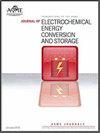Experimental and computational analysis of thermal runaway behavior of lithium ion pouch battery at low ambient pressure
IF 1.9
4区 工程技术
Q3 ELECTROCHEMISTRY
Journal of Electrochemical Energy Conversion and Storage
Pub Date : 2022-11-30
DOI:10.1115/1.4056328
引用次数: 0
Abstract
Safety issue concerning the “thermal runaway behavior” of lithium-ion battery (LIB) is a major concern of users. In this paper, the thermal runaway (TR) behaviors at different ambient pressures were studied. The thermal runaway onset time (t1) occured in advance as the ambient pressure decreased from 90 kPa to 50 kPa (90 kPa, 80 kPa, 70 kPa, 60 kPa, and 50 kPa). At 50 kPa, thermal runaway onset time of LIBs was 177 seconds earlier than that at 90 kPa. The values of heat release rate (HRR), total heat release (THR), battery peak surface temperature and peak flue gas temperature declined with the decreasing ambient pressure. Moreover, the peak concentrations of CxHy and CO increased with the decrease of ambient pressure, whereas the peak concentration of CO2 and NO showed the opposite trend. Based on the previous studies of the thermal analysis kinetics model of LIBs, a pressure correction factor kp was introduced to establish a prediction model for thermal runaway temperature at low pressure conditions. Based on the model output, the error of thermal runaway onset time t1 could be controlled within ±2 s, and the error of thermal runaway peak temperature Tmax could be controlled within ±2 °C. The experimental results were well consistent with the simulation results. The results of this study are beneficial to better reveal the thermal runaway behavior of LIBs under low ambient pressure.低环境压力下锂离子袋电池热失控行为的实验与计算分析
锂离子电池(LIB)“热失控行为”的安全问题是用户关注的主要问题。本文研究了不同环境压力下的热失控行为。当环境压力从90kPa降低到50kPa(90kPa、80kPa、70kPa、60kPa和50kPa)时,热失控开始时间(t1)提前发生。在50kPa下,LIBs的热失控开始时间比在90kPa下早177秒。放热率(HRR)、总放热率(THR)、电池峰值表面温度和峰值烟气温度的值随着环境压力的降低而下降。此外,CxHy和CO的峰值浓度随着环境压力的降低而增加,而CO2和NO的峰值浓度则呈现相反的趋势。在前人对LIBs热分析动力学模型研究的基础上,引入压力修正因子kp,建立了低压条件下热失控温度的预测模型。根据模型输出,热失控开始时间t1的误差可以控制在±2s以内,热失控峰值温度Tmax的误差可以在±2°C以内。实验结果与仿真结果吻合较好。本研究的结果有利于更好地揭示LIBs在低环境压力下的热失控行为。
本文章由计算机程序翻译,如有差异,请以英文原文为准。
求助全文
约1分钟内获得全文
求助全文
来源期刊

Journal of Electrochemical Energy Conversion and Storage
Engineering-Mechanics of Materials
CiteScore
4.90
自引率
4.00%
发文量
69
期刊介绍:
The Journal of Electrochemical Energy Conversion and Storage focuses on processes, components, devices and systems that store and convert electrical and chemical energy. This journal publishes peer-reviewed archival scholarly articles, research papers, technical briefs, review articles, perspective articles, and special volumes. Specific areas of interest include electrochemical engineering, electrocatalysis, novel materials, analysis and design of components, devices, and systems, balance of plant, novel numerical and analytical simulations, advanced materials characterization, innovative material synthesis and manufacturing methods, thermal management, reliability, durability, and damage tolerance.
 求助内容:
求助内容: 应助结果提醒方式:
应助结果提醒方式:


